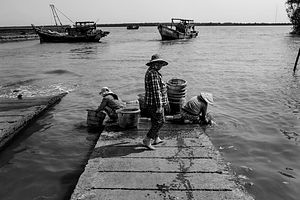Luc Forsyth and Gareth Bright have set out on a journey to follow the Mekong river from sea to source, The Diplomat will be sharing some of the stories they’ve found along the way. For more about the project, check out the whole series here.
A River’s Tail started as few serious endeavors should — with Rambo II. Dubbed into Vietnamese by overly enthusiastic voice actors, none of the local passengers seemed bothered in the least by Sylvester Stallone’s killing spree through the Mekong Delta. Many chuckled periodically as their fictitious countrymen fell to Rambo’s merciless knife.
Col. Trautman: “Where are you going, John?”
John Rambo: “I don’t know.”
As inappropriate as the film selection on the Phnom Penh – Ho Chi Minh City (Saigon) bus route may have been, we found an unlikely counterpoint to our own feelings of uncertainty about the journey ahead in Rambo’s ever-stoic words. After months of endless preparation and speculation about how to best document the health of the Mekong River and the stories of the people living from its waters, we were less than an hour from the Vietnamese border with no real picture of what lay ahead.
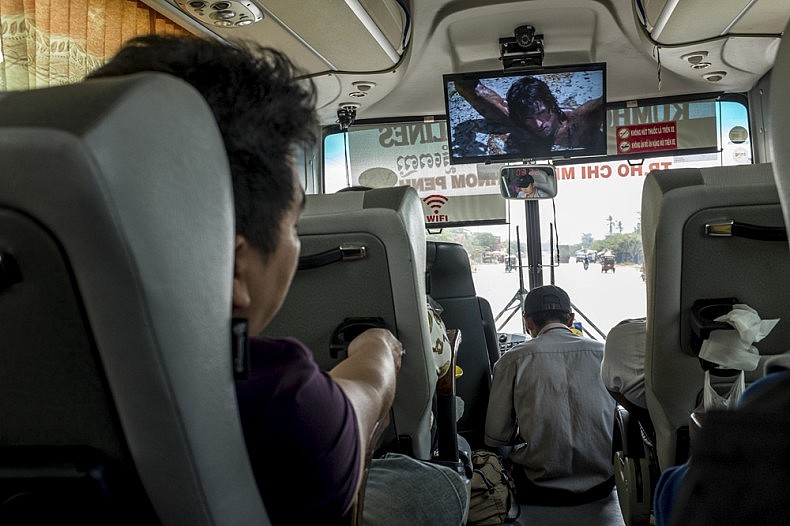
A scene from the Rambo as seen from the inside of the bus from Phnom Penh to Ho Chi Minh City as we start our first leg of the A River’s Tail Journey in Vietnam. Photo by Luc Forsyth.
Looking across the aisle of the bus, Pablo Chavanel, the project’s chief videographer, was shooting sporadic b-roll footage of the dusty Cambodian countryside while glancing indifferently at the blaring TV screen. In contrast, fellow photographer Gareth Bright — an unapologetic fan of the Rambo series — had his eyes glued to the film. That our 20 kg aerial camera drone was wedged under his legs didn’t seem to bother him, though it had to have been impossibly uncomfortable.
Where were we going? Perhaps more importantly, what would we do when we got there? Documenting the entirety of the Mekong from sea to source over a one year period seemed like a fairly straightforward idea during our project meetings in Phnom Penh’s coffee shops, but as we drove further and further from the comforts of our apartments, our best laid plans seemed meaningless in the face of the vagaries ahead.
When the middle aged Vietnamese man in the seat next to me turned his iPad to full volume, the bus’ on board Wi-Fi allowing him to stream Justin Bieber’s “Baby” to his heart’s content, I glanced back at my colleagues to see Pablo drifting into sleep. The French, it would seem, have little love for Rambo.
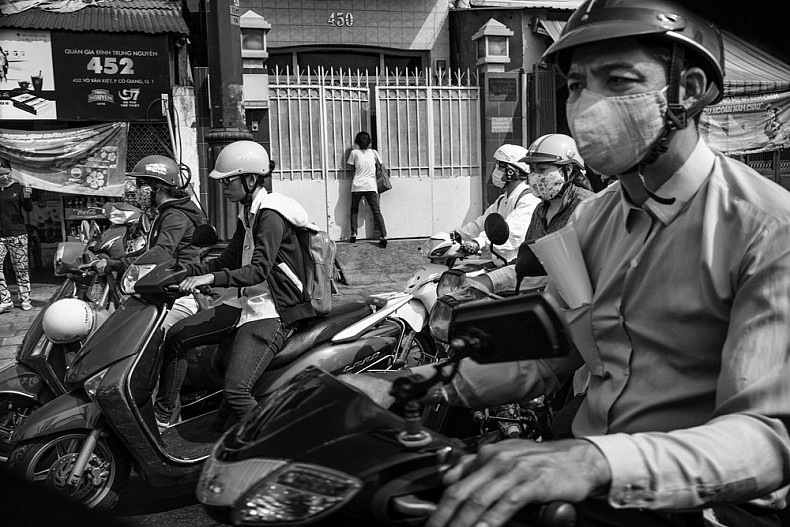
Traffic congestion just outside Ho Chi Minh City, Vietam as we make our way south to coast of Vietnam where the Mekong meets the South China Sea. Photo by Gareth Bright.
Heading South
The border station at Bavet/Moc Dai (the respective Cambodian and Vietnamese towns), provided subtle insights into the cultural and political differences between the two countries. While the Cambodian side was comprised of a relatively welcoming collection of squat pseudo-traditional tiled structures, the hard grey concrete of Vietnam’s immigration checkpoint — alternately adorned with the red and yellow of the Vietnamese flag and the hammer and sickle banners of the Communist party — seemed far more imposing. And while we passed through without any problems, save for a cursory (and surprisingly disinterested) inspection of our Star Wars-looking drone, officially arriving on Vietnamese soil made the start of the project all the more real.
We entered Saigon a few hours later, changed our dollars into dong, and secured a musty dorm room for the night. Our fixer/translator, Mi, arrived late that evening and after a quick meeting to get to know each other and discuss our departure time the next day, we took to our beds. With the approach of sleep the unanswerable questions returned — how exactly were we going to pull this off? Where were we going?
After conferring over distances and travel times with the driver we had hired to help us move around the sprawling Mekong delta (a relentlessly energetic young man who asked us to call him Stephen), we opted to head for the coastal province of Tan Thanh. In theory, the plan was simple. Get to the sea and then follow the river back to Cambodia, meeting as many people along the way as possible.
Stephen, dressed smartly in dark slacks and a blue button down shirt (neither of which we ever saw him wear again, as he apparently discerned quite quickly we were not formal types), piloted his Toyota Zace 4×4 towards the ocean, stopping only once, at a gaudy roadside restaurant appropriately named The Mekong Rest Stop. As we stood around the car sipping terribly strong coffee, Stephen made the first quip in what was to become a profoundly unorthodox (and wonderful) working relationship. Staring at Pablo’s shaved head he noted gravely, “You look like Vin Diesel. I drive like Vin Diesel. Fast and Furious.”
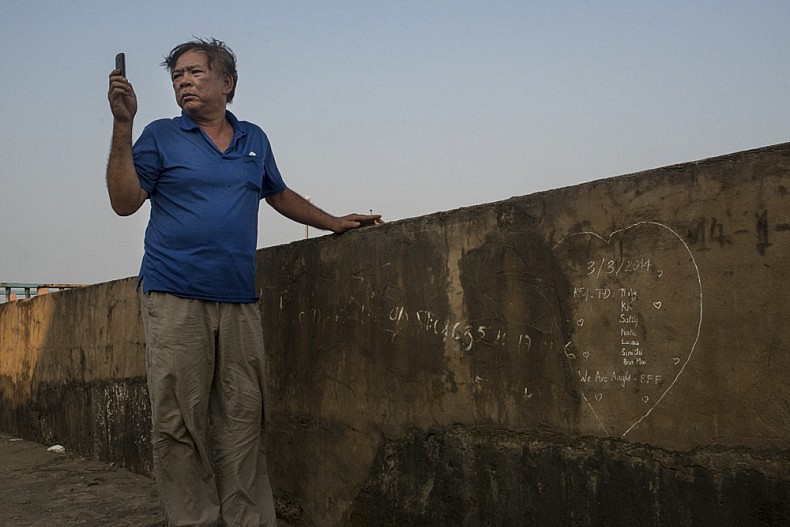
A man checks his cell phone at a popular tourist rest stop on the coast of the South China Sea. The South China Sea is known as the Eastern Sea by the Vietnamese. Photo by Luc Forsyth.
The Eastern Sea
At its terminus, the Mekong and the sea are barely distinguishable from one another. The river’s sediment-laden water and the ocean’s chop blend together organically, and it is difficult to tell exactly where one ends and the other begins. The only noticeable difference was in the concentration of tourists — nearly all Vietnamese apart from us — who flocked around the coastal seawall, but seemed completely disinterested in the river banks.
We spent most of the remaining daylight bouncing back and forth between the river and the seashore, trying to find the first traces of a story. Looking past the throngs of seafood-hungry tourists, our first impressions of the coast were mixed. A beautiful if aging pier extended a few hundred meters out into the water and made for an idyllic evening backdrop, while clam harvesters worked the beach, their backs hunched towards the sand. Stilted wooden houses stood above the tides, their windows opened to receive the sea breeze.
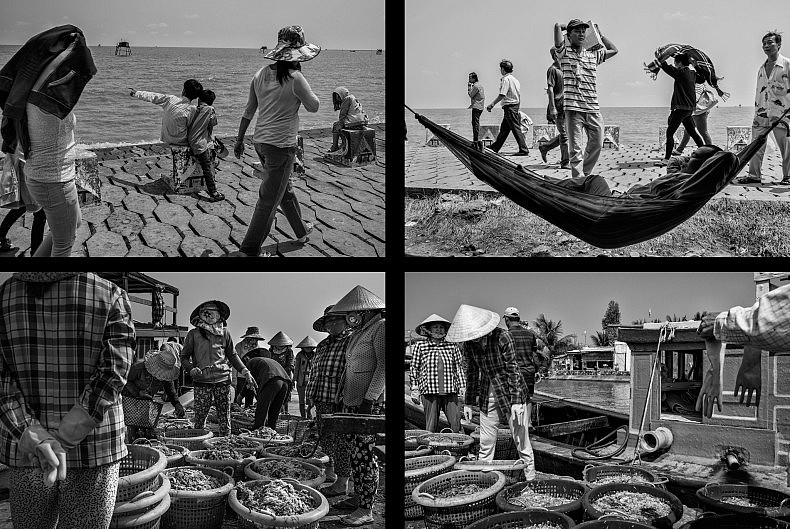
Top: Local Vietnamese tourists enjoy the view of the ocean (L) and a man rests in a hammock after a seafood lunch from one of the many restaurants along the boardwalk (R). Bottom: Workers sort the day’s shrimp catch and sort the seafood before sending it to family owned processing facilities. Photos by Gareth Bright.
The scene would have been wonderfully picturesque had it not been for the plastic. An endless mottled mass of shopping bags and Styrofoam food containers in various states of decay were bunched around the foundational pylons of the community. After spending more than 12 years in Southeast Asia collectively, we were all aware that the economic realities of lower class life in the region prevent many people from making carbon-free lifestyle choices. We understood it was neither fair nor realistic to expect that nearby farmers living near the poverty line could switch to reusable shopping bags or washable diapers, but the sight of such heavy pollution at the absolute start of a long trip was disquieting nonetheless. Where exactly was it coming from and where did it go, we wondered? What did it mean in relation to human and animal health?
Deciding that the touristic nature of the seaside made it an unsuitable place to question locals on the health of the water, we returned to the Mekong. In the quiet town of Den Do, we stopped at a concrete pier and chatted with a few men who were squatting idly, smoking cigarettes. Den Do, they said, was all about shrimp.
Twenty minutes later, a dilapidated wooden vessel pulled alongside and seemingly out of nowhere dozens of men, women, and children rushed out to meet it. In a frenzy of activity the cargo hold of the ship was emptied of its catch; shrimp did indeed seem to be the main business. Through Mi we learned that the community was entirely reliant on the ocean for their living and used the river solely as a means of transportation and distribution. Though it wasn’t exactly the Mekong-centric start to the trip that we might have imagined, we decided that if that was the reality, then that is what we would start with. With Mi’s help we secured the permission of a gravel-voiced boat captain to join his crew for the next morning’s fishing.
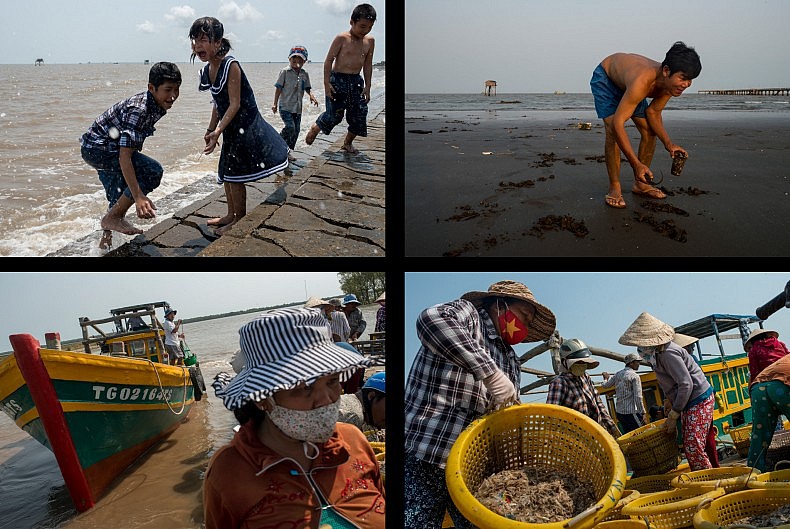
Top: Children splashed by a rogue wave as they hunt for clams along the boardwalk and a man harvests clams from the beach. Bottom: A shrimp boat pulls into harbour in the town of Den Do to offload its catch. Shrimp is a $4 billion industry in Vietnam and is one of the fastest growing sectors of Vietnam’s seafood exports. Photos by Luc Forsyth.
With a 3:30 a.m. wake up looming, we sought out an early dinner. Too tired to look for other options, we ordered from the first restaurant we could find. For a reason that never was made clear to us, the owner was strongly opposed to cooking by any other means than by boiling everything together in a single pot. Yet as we grumbled our acceptance, Stephen leapt into action, forcing his way into their kitchen and shouting for cooking utensils. Ordering three nonplussed cooks to prep specific vegetables and bring him pans, he deftly stir-fried three full courses of clams, shrimp, and squid. When he finally joined us at the table, he brushed off our bemused stares.
“I can drive like Vin Diesel. And I can cook.”
And cook he could. With seemingly half the ocean in our stomachs we found the closest guest house — a sparse and mildewy building shared by a family of dogs who barked furiously at our slightest move — and bedded down for a cruelly short sleep. The perfect start.
This piece originally appeared at A River’s Tail.













